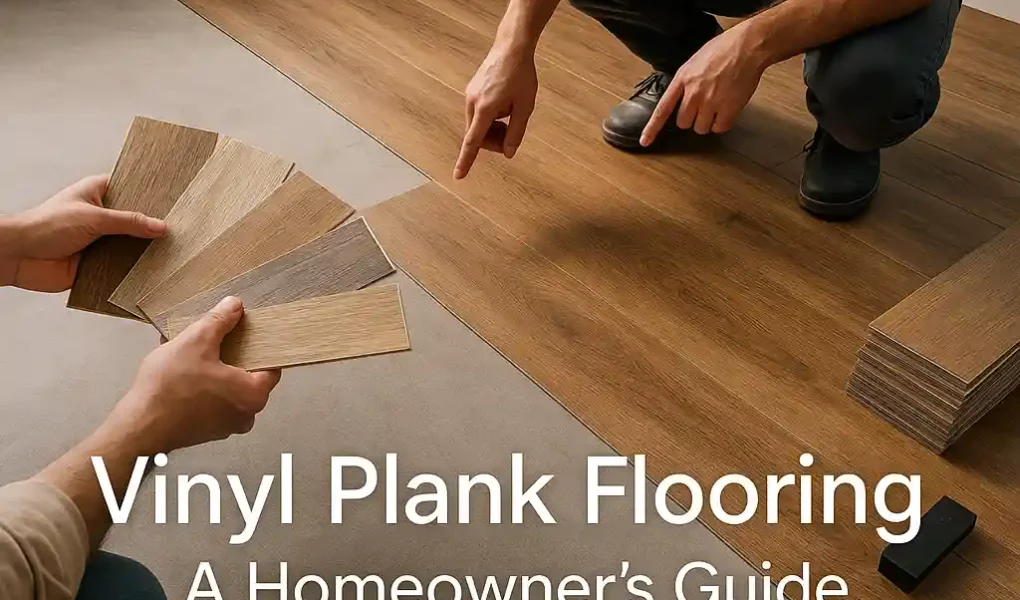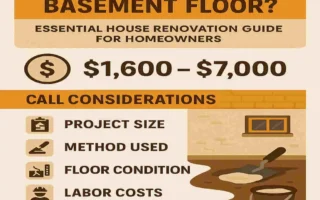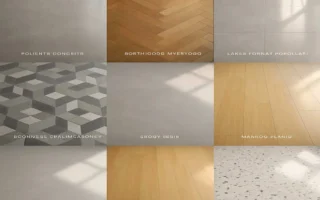The reason vinyl plank flooring keeps winning kitchens, basements, and busy hallways isn’t just “waterproof” marketing, it’s predictability. Done right, LVP and SPC shrug off puddles, pet claws, chair legs, and daily grit while looking convincingly like wood. Done wrong, they telegraph subfloor waves, gap in sunrooms, and click at thresholds. The difference isn’t luck or brand hype; it’s choosing the right product for the room and getting the invisible parts such as flatness, moisture, and expansion exactly right. This guide distills what matters so your new floor looks great on day one and still feels solid in year five with rel=nofollow vinyl plank flooring.
What Vinyl Plank Actually Is (and Why It Works)
“Vinyl plank” is an umbrella for a few constructions that all aim to deliver realistic wood visuals with practical performance. Traditional LVP (luxury vinyl plank) uses a flexible vinyl core that’s forgiving over minor subfloor imperfections and comfortable underfoot. SPC (stone-plastic composite) stiffens the core with mineral content, making planks exceptionally dimensionally stable in heat and sun, great for big windows and temperature swings. WPC (wood-plastic composite) sits between them: a rigid core with a slightly cushier feel than SPC, attractive for family rooms and bedrooms.
What they share is a photo-realistic wear layer protected by a durable urethane finish (often ceramic-bead enhanced for scratch resistance), simple plank-by-plank replacement if something goes wrong, and install paths that suit remodels without demolition chaos. The biggest mistake houseowners make is assuming “vinyl is vinyl.” Match the core to the room conditions and you’ve won half the battle.
Where Vinyl Plank Shines and Where It Needs Help
Kitchens and mudrooms love vinyl plank because it’s easy to clean and resists denting from daily life. Basements benefit from click-lock floating assemblies that ride over small slab imperfections without telegraphing every ripple. Rentals and pet households appreciate that individual planks can be swapped out if someone drops a skillet or a dog skids a turn. South- and west-facing rooms can also be wins when you choose SPC for thermal stability and plan basic sun control.
Where vinyl needs help is at the edges: long, uninterrupted runs without breaks, sun-baked glass walls with no shading, and wet rooms that depend on grout sealer instead of proper waterproofing behind tile. None of those are deal-breakers; they simply require the right product choice and a few details that keep the system in its comfort zone.
Six Buying Signals That Actually Matter
- Wear layer and finish
Aim for 12–20 mil wear layers in busy houses and 20+ mil in rentals or heavy-use zones. Ceramic-bead or enhanced urethane finishes fend off micro-scratches from chair legs and pet claws because they harden the surface, not just gloss it. - Core type matched to the room
Lots of direct sun or big temperature swings? Choose SPC for dimensional stability. Want maximum forgiveness over wavy subfloors? Flexible LVP hides small imperfections better. Prefer a slightly softer feel? WPC often wins the living room. - Locking profile quality
Click systems are not created equal. Tight, repeatable machining reduces seasonal gaps and squeaks. Dry-fit a few rows from two brands before you buy—your hands will feel the difference. - Subfloor flatness plan
Most products ask for deviations no greater than about 3/16″ in 10′. Thick planks don’t “fix” a wavy floor; patch and skim where needed so the new surface reads smooth and silent. - Health and emissions
Favor FloorScore or GREENGUARD Gold certified products and low-VOC adhesives where used. You’ll smell the difference on install day and breathe easier long term. - Warranty rules you can actually meet
Every warranty has non-negotiables: acclimation hours, room RH and temperature ranges, maximum surface temperature over radiant (often ~85°F/29°C), and expansion gap requirements. Choose a product whose rules fit your house so you can follow them without heroics.
Subfloor, Moisture, and the Prep That Makes or Breaks the Job
A beautiful vinyl floor is half product and half substrate. Wood subfloors should be quiet and solid before you ever open a box: add screws along joists and at seams to kill squeaks, sand high edges, and fill low spots. Concrete wants to be flat, clean, and dry to the manufacturer’s limits. If you’re on a newer slab or a basement with a moisture history, budget for mitigation approved by the flooring maker and adhesive you’ll use (glue-down) or the pad you’ll lay (floating). Plan transitions at doorways and stairs now, not as a last-minute scramble.
Installation Paths, Without the Guesswork
Click-lock floating is the right answer for most occupied homes and remodels. It’s fast, clean, and keeps future repairs simple. Respect the expansion margin around walls and fixed objects, stagger end joints, and use the tapping block sparingly, crushing a locking lip creates a permanent hotspot for clicks and gaps.
Glue-down excels in long corridors, home gyms, and rooms with heavy rolling loads or furniture on casters. It demands tighter flatness and the exact adhesive the manufacturer approves for your substrate moisture. Follow open time, roll with the specified weight, and protect the floor until cure. The result feels planted and resists movement under stress.
Neither method is universally “better”; the right choice is the one that matches your room’s use and your tolerance for prep and curing time.
Radiant Heat, Sun, and Seasonal Swings
Vinyl plank and radiant heat can be a great pairing when you respect temperature limits. Most products specify maximum surface temperatures around 85°F/29°C and want a slow warm-up after installation. In sun-heavy rooms, SPC’s rigidity keeps seams tight through afternoon peaks, and simple shading (interior shades or low-E glass you already have) dramatically reduces heat load. Floating floors also need breaks on very long runs, manufacturers call for T-moldings at certain distances so the assembly can breathe without telegraphing stress into the locking system.
Sound and Comfort Without Compromise
Underfoot feel and acoustics matter as much as looks. Dense, closed-cell underlayments tame hollow sound under SPC and make upstairs rooms more neighbor-friendly. Where building rules set acoustic minimums, look for products and pads with tested assemblies that meet required IIC or ΔIIC ratings. Just as important: don’t stack underlayments with an attached-pad plank unless the manufacturer explicitly allows it, extra cushion can overload the locking system and void warranties.
Living With Vinyl Plank: Pets, Spills, and Everyday Chaos
Daily life is where vinyl plank earns its reputation. Wipe spills as you go and keep entrance mats where grit comes in; you’ll dramatically extend surface life. Felt pads under chairs are cheap insurance. If a plank takes a hit, floating floors let you unlock back to the damage and swap only what’s needed. In glue-down rooms, most brands offer repair guidance and color-matched fillers, but prevention is still better, protect heavy point loads and sliding furniture with wide glides and mats.
Maintenance That Actually Works
The routine is simple: vacuum or dust-mop on a hard-floor setting, then damp-mop with the manufacturer’s cleaner. Skip steam mops and solvent chemicals that chase shine but attack finishes. Sun-exposed rooms appreciate blinds during peak hours to reduce fading and heat cycles. That’s it. Do those basics and you’ll avoid 90% of the issues that send homeowners hunting for repair kits.
Two Micro Case Studies
Dogs, kids, and a hard-working kitchen
A family with two large dogs wanted a floor that cleaned easily but didn’t sound hollow. We specified a 20-mil, ceramic-bead LVP over a skim-coated plywood subfloor, click-locked with a dense underlayment approved by the manufacturer. The prep eliminated seam telegraphing; the finish shrugged off bowl splashes and claw traffic; the underlayment softened footfall without introducing bounce. One year in, the joints are tight, the finish is intact, and the room sounds like a home, not a gym.
Sunroom with big west-facing glass
Afternoon heat had cupped previous floors and gapped a laminate. The solution was rigid-core SPC with documented thermal stability, planned breaks at long transitions, and simple shading to lower peak surface temperatures. By designing for expansion and controlling solar load, seams stayed flat through July heat. The homeowner finally got a wood look that didn’t punish them for loving sunlight.
Four Quick FAQs Homeowners Ask
Is SPC better than LVP?
Different, not better. SPC holds shape in heat and direct sun; flexible LVP is more forgiving over imperfect subfloors. Pick based on the room, not the buzzword.
What wear layer should I buy?
Busy homes with pets do well at 12–20 mil; rentals or very high traffic often start at 20+ mil. The coating quality matters as much as the number.
Can I use vinyl plank with radiant heat?
Usually yes—keep surface temps under the product’s published limit (often ~85°F/29°C) and warm up gradually after install.
Do I need underlayment if the plank has a pad?
Only if the manufacturer allows it. Many attached-pad products are designed to be laid directly over the approved subfloor; extra layers can introduce movement or void the warranty.
Eight Mistakes to Avoid
- Skipping subfloor flatness and hoping the pad “fixes it”
- Ignoring acclimation, room humidity, and temperature limits
- Running floating floors tight to walls, cabinets, islands, or posts
- Spanning long distances without required T-moldings or breaks
- Using the wrong adhesive for slab moisture conditions on glue-down
- Mixing attached-pad planks with extra underlay against instructions
- Steam mopping or using harsh solvents on urethane finishes
- Forgetting sun load at big south- and west-facing windows
From the Field
After installing thousands of square feet across kitchens, basements, and sunrooms, one pattern holds: great vinyl plank projects are won or lost before the first row goes down. The homeowners who end up happiest chose a product that fits their room’s realities and invested a little extra in prep. When those two decisions are right, the installation is straightforward and the floor looks like real wood without the daily worry, exactly why many families work with experienced crews like Patriot Property Pros for planning and execution.




